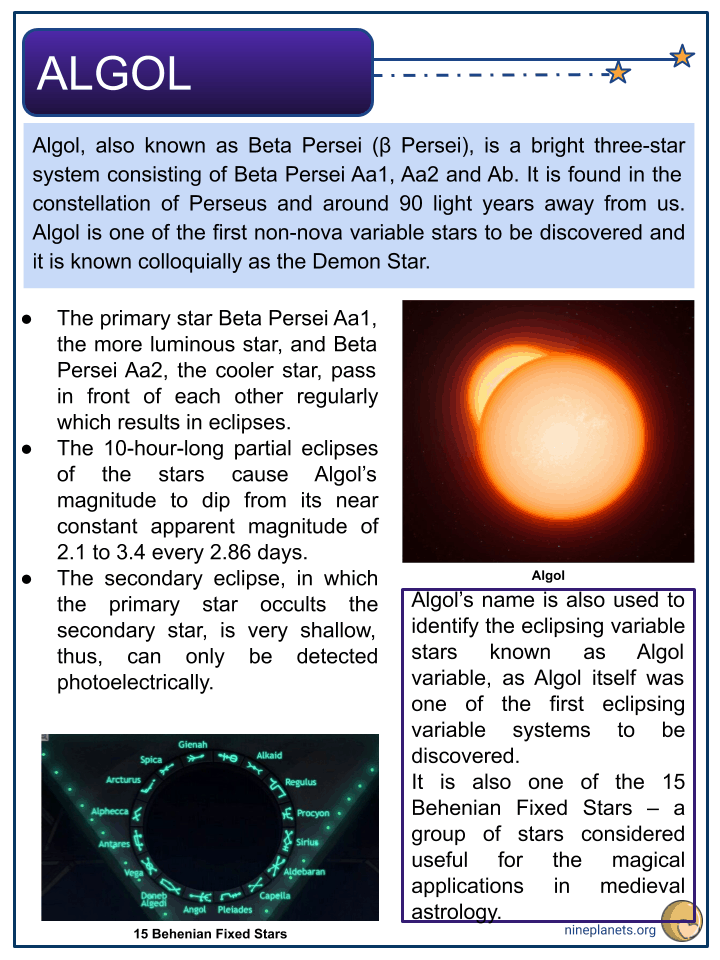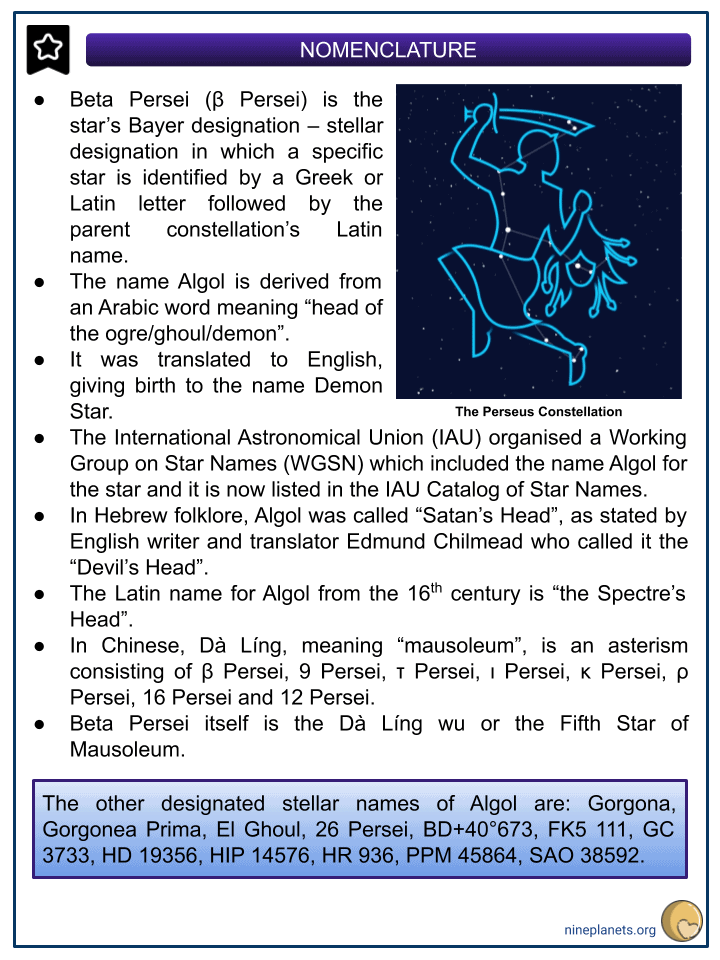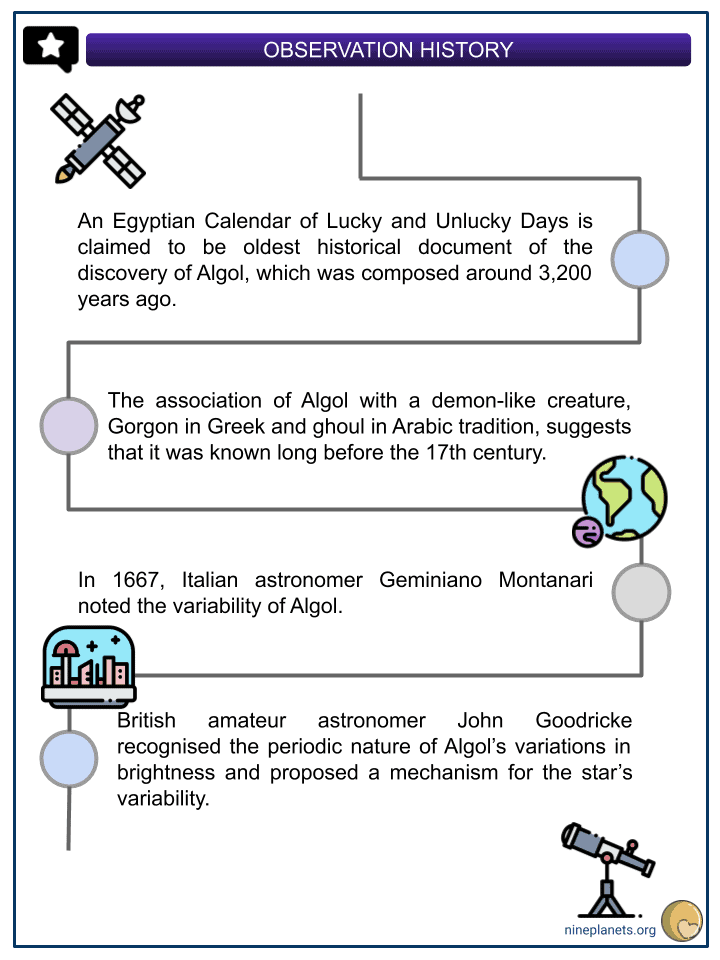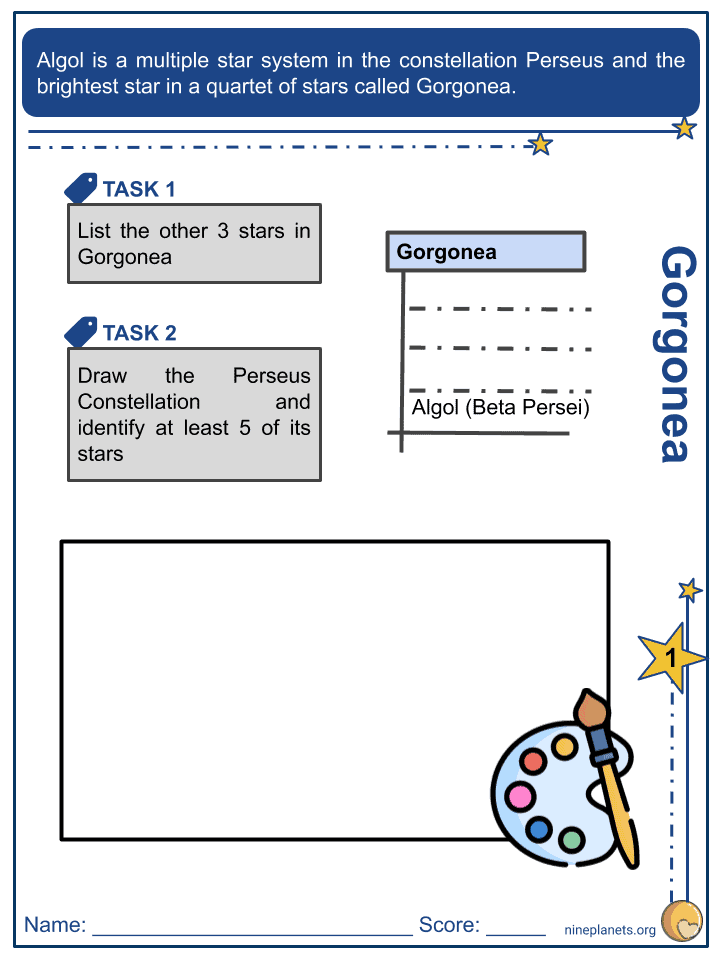Download Algol Worksheets
Click the button below to get instant access to these premium worksheets for use in the classroom or at a home.
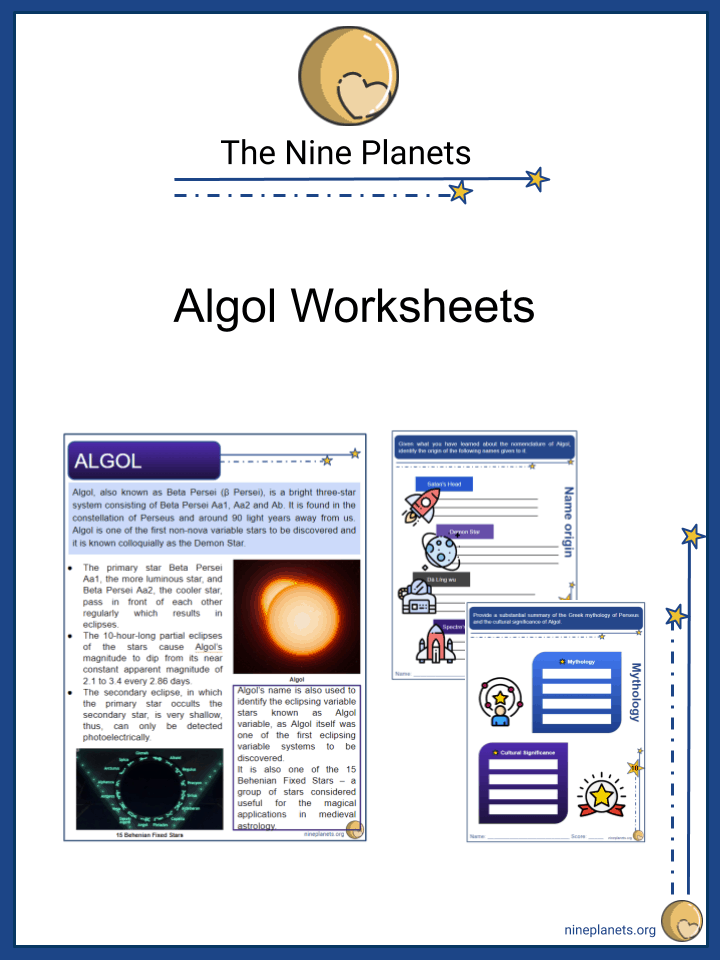
This worksheet can be edited by Premium members using the free Google Slides online software. Click the Edit button above to get started.
Download free sample
Not ready to purchase a subscription yet? Click here to download a FREE sample of this worksheet pack.
Resource Examples
Click any of the example images below to view a larger version.
Key Facts & Information
- Algol, also known as Beta Persei (β Persei), is a bright three-star system consisting of Beta Persei Aa1, Aa2 and Ab. It is found in the constellation of Perseus and around 90 light years away from us. Algol is one of the first non-nova variable stars to be discovered and it is known colloquially as the Demon Star.
- The primary star Beta Persei Aa1, the more luminous star, and Beta Persei Aa2, the cooler star, pass in front of each other regularly which results in eclipses.
- The 10-hour-long partial eclipses of the stars cause Algol’s magnitude to dip from its near constant apparent magnitude of 2.1 to 3.4 every 2.86 days.
- The secondary eclipse, in which the primary star occults the secondary star, is very shallow, thus, can only be detected photoelectrically.
- Algol’s name is also used to identify the eclipsing variable stars known as Algol variable, as Algol itself was one of the first eclipsing variable systems to be discovered.
- It is also one of the 15 Behenian Fixed Stars – a group of stars considered useful for the magical applications in medieval astrology.
Nomenclature
- Beta Persei (β Persei) is the star’s Bayer designation – stellar designation in which a specific star is identified by a Greek or Latin letter followed by the parent constellation’s Latin name.
- The name Algol is derived from an Arabic word meaning “head of the ogre/ghoul/demon”.
- It was translated to English, giving birth to the name Demon Star.
- The International Astronomical Union (IAU) organised a Working Group on Star Names (WGSN) which included the name Algol for the star and it is now listed in the IAU Catalog of Star Names.
- In Hebrew folklore, Algol was called “Satan’s Head”, as stated by English writer and translator Edmund Chilmead who called it the “Devil’s Head”.
- The Latin name for Algol from the 16th century is “the Spectre’s Head”.
- In Chinese, Dà Líng, meaning “mausoleum”, is an asterism consisting of β Persei, 9 Persei, τ Persei, ι Persei, κ Persei, ρ Persei, 16 Persei and 12 Persei.
- Beta Persei itself is the Dà Líng wu or the Fifth Star of Mausoleum.
- The other designated stellar names of Algol are: Gorgona, Gorgonea Prima, El Ghoul, 26 Persei, BD+40°673, FK5 111, GC 3733, HD 19356, HIP 14576, HR 936, PPM 45864, SAO 38592.
Observation History
- An Egyptian Calendar of Lucky and Unlucky Days is claimed to be oldest historical document of the discovery of Algol, which was composed around 3,200 years ago.
- The association of Algol with a demon-like creature, Gorgon in Greek and ghoul in Arabic tradition, suggests that it was known long before the 17th century.
- In 1667, Italian astronomer Geminiano Montanari noted the variability of Algol.
- British amateur astronomer John Goodricke recognised the periodic nature of Algol’s variations in brightness and proposed a mechanism for the star’s variability.
- In May 1783, he presented his findings to the Royal Society which suggests that the periodic variability was due to a dark body passing in front of star. This gained him the Copley Medal award.
- In 1881, the Harvard astronomer Edward Pickering presented evidence that the star was actually an eclipsing binary.
- In 1889, the Potsdam astronomer Hermann Carl Vogel found periodic doppler shifts in the spectrum of Algol which infers variations in its radial velocity, confirming Pickering’s evidence.
- The first photoelectric study of a variable star was produced by American astronomer Joel Stebbins at the University of Illinois Observatory using an early selenium cell photometer.
- Algol was called the Demon Star due to its location in Perseus constellation, which marks the head of the celestial Medusa.
Stellar System
- Algol is a multiple-star system with three confirmed stars and two other suspected stellar components.
- Beta Persei Aa1 and Beta Persei Aa1 form an eclipsing binary from the point of view of the Earth as their orbital plane contains the line of sight to the Earth.
- The eclipsing binary is only 0.062 away from each other and the third star Beta Persei Ab is around 2.69 AU away from the binary pair.
- The binary stars orbit each other within a period of 2 days 20 hours and 49 minutes.
- The third component revolves around the main binary system every 1.85 years.
- The mutual orbital period of the trio is around 681 days.
- The Washington Double Star Catalog lists them as Aa1, Aa2, and Ab with two very faint stars B and C.
- The Algol paradox in the theory of stellar evolution is a paradoxical situation in which elements of a binary star seem to evolve in discord.
- The more massive star is still in the main sequence but the less massive star is a subgiant at a later evolutionary stage, although components of a binary star form at the same time and massive stars evolve much faster.
- This paradox can be solved by mass transfer, in which the more massive star became a subgiant and most of its mass was transferred to the other star, which is still in the main sequence.
- The stars system exhibits some X-ray and radio wave flares. The X-ray flares were believed to be caused by the magnetic fields of the two stars interacting with their mass transfer.
- The magnetic fields of the two stars are around 10 times stronger than the Sun.
- Beta Persei Aa1
- Beta Persei Aa1, the primary star, is the biggest star with around 3.17 solar masses and a radius of around 2.73 solar radii.
- Beta Persei Aa1 is a blue main-sequence star of spectral type B8V. It has a luminosity of 182 and a temperature of 13,000 K.
- Its surface gravity is around 4 cgs and it is a fast spinner with a rotational velocity of 49 km/s.
- The primary star is believed to have formed 570 million years ago.
- Its absolute magnitude is -0.07.
- Beta Persei Aa2
- Beta Persei Aa2, the secondary star, is the smallest star with around 0.7 solar masses and a radius of around 3.48 solar radii.
- Beta Persei Aa2 is an orange subgiant star of spectral type K0IV.
- It is much fainter and cooler with an average surface temperature of 4,500 K and with a luminosity of 6.92.
- Its surface gravity is around 3.5 cgs and its absolute magnitude is around 2.9.
- Beta Persei Ab
- Beta Persei Ab, the third star, is an A-class star of spectral type A7m with around 1.76 solar masses and a radius of around 1.73 solar radii.
- It is 10 times brighter than the Sun and has a surface gravity of 4.5 cgs.
- Its temperature is around 7,500 K, 1.2 times hotter than the Sun, and its absolute magnitude is around 2.3.
Perseus
- Perseus is found in the northern sky and is named after the Greek mythological hero Perseus.
- It is one of the 48 constellations listed by Ptolemy in the Almagest. It is also among the 88 modern constellations defined by the International Astronomical Union (IAU).
- In Greek mythology, Perseus was the son of Danae and was sent by King Polydectes to bring the head of Gorgon Medusa.
- He was blessed by the gods and goddesses with weapons to defeat the Gorgon.
- Perseus slew Medusa in her sleep and rescued Andromeda by killing Medusa with his sword.
- He then turned Polydectes and his followers into stone, using Medusa’s head. Perseus then got married to Andromeda and had six children.
- Cultural Significance of Algol
- Historically, Algol had a strong association with bloody violence among different cultures.
- In the Tetrabiblos, the 2nd-century astrological text of Ptolemy, Algol is referred to as “the Gorgon of Perseus” and is associated with death by decapitation. Algol is considered one of the unluckiest stars in the sky.
Did You Know?
- Algol was called the Demon Star due to its location in the Perseus constellation which marks the head of the celestial Medusa.
- The 15 Behenian Fixed Stars were associated with planets and influencing them in an astronomical sense.
- They were also associated with gemstones or plants, making them useful in magic rituals.
- Beta Persei was associated with bad luck, death due to beheading, violence, and was associated with the planets Saturn and Jupiter, the diamond gemstone, and the black hellebore plant.
- The 15 Behenian Fixed Stars are: Algol, Pleiades, Aldebaran, Capella, Sirius, Procyon, Regalus, Alkaid, Algorab, Spica, Arcturus, Alphecca, Antares, Vega, and Deneb Algedi.
- Algol is most likely formed from a molecular cloud of dust and gas.
- The swirling gas and dust were pulled together by the gravity, giving birth to the Demon Star.
- The Medieval Arabic commanders would try to ensure that no important battles would happen while Algol’s light was faint.
- In the future, Algol will eventually suffer a core-collapse and as its temperature rises, its outer layer will expand outwards together with its companion, Beta Persei Aa2.
- A lot of astrologers believe that Algol was the most unfortunate, violent, and dangerous star in the heavens.
- Algol is among the most observed stars in the northern sky and the most noteworthy variable star.
- The eclipses on Beta Persei can be observed with the naked eye.
- Around 7.3 million years ago, Algol was only 9.8 light years away from us and its apparent magnitude was -2.5, which is much brighter than Sirius today.
- It is believed that Algol’s passing caused gravity perturbations in the Oort Cloud, thus increasing the number of comets entering the inner Solar System.
- The other major stars of Perseus are: Mirfak, Atik, Epsilon Persei, Gamma Persei, Delta Persei, Gorgonea Tertia, Miram, Misam, Nu Persei, Atik, Menkib, Seif, Iota Persei, Theta Persei, Psi Persei, Gorgonea Quarta, Gorgonea Secunda, 1 Aurigae, X Persei, Nova Persei, and V713 Persei.
- Beta Persei is the brightest star in a quartet of stars called Gorgonea, together with Pi Persei, Rho Persei and Omega Persei.
